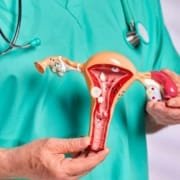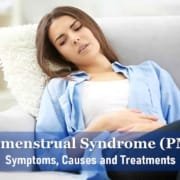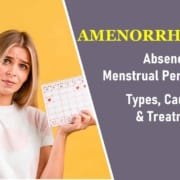Painful Periods – Menstrual Cramps – Dysmenorrhea
Painful Periods or Menstrual cramps also known as Dysmenorrhea, is pain during menstruation. It commonly starts when menstruation commences, with symptoms typically lasting less than three days. The discomfort is typically felt in the pelvis or lower abdomen, and additional symptoms may involve back pain, diarrhea, or nausea.
Period pain is estimated to occur in 20% to 90% of women of reproductive age. It is the most common menstrual disorder. Typically it starts within a year of the start of menstrual period. When there is no underlying cause often the pain improves with age or after childbirth.
In young women painful periods often occur without any underlying problem. However, in older women, it is more commonly associated with underlying problems such as uterine fibroids, adenomyosis, or endometriosis. This condition is more prevalent among women experiencing heavy or irregular periods, early onset of menstruation before twelve years of age, or those with a low body weight.
Period pain occurs less often in women who exercise regularly and those who have children early in life.
Types of period pain?
Dysmenorrhea may be either primary or secondary.
- Primary Dysmenorrhea. This happens when you first start your period and continues throughout your life. It is usually life-long. It can cause severe and frequent menstrual cramping due to severe and abnormal uterine contractions.
- Secondary dysmenorrhea. This type is due to some underlying cause. It usually starts later in life. It may be caused by another medical condition. This includes pelvic inflammatory disease, endometriosis, adenomyosis or uterine fibroids.
What causes period pain?
Women with primary dysmenorrhea have abnormal contractions of the uterus due to a chemical imbalance in the body. For example, the chemical prostaglandin that controls the contractions of the uterus.
Secondary dysmenorrhea is attributed to other medical conditions, typically with endometriosis being the most common cause. Endometriosis is a condition wherein endometrial tissue implants itself outside the uterus. Endometriosis often causes internal bleeding, endometriotic cysts, and pelvic pain.
Other causes of secondary dysmenorrhea include the following:
- Pelvic inflammatory disease (PID)
- Uterine fibroids
- Abnormal pregnancy (miscarriage, ectopic)
- Infection, tumors, or polyps in the pelvis.
What are the symptoms of period pain?
The following are the most common symptoms of period pain. However, each person may experience symptoms differently. Symptoms may include:
- Cramping in the lower belly
- Pain in the lower belly
- Low back pain
- Pain radiating down the legs
- Nausea
- Vomiting
- Diarrhea
- Fatigue
- Weakness
- Fainting
- Headaches
The symptoms of period pain may look like other conditions or medical problems. Always talk your gynecologist for a diagnosis.
What are the risk factors for period pain?
While any woman can develop period pain, the following women may be at an increased risk for the condition:
- Women who smoke.
- Women who consume alcohol during their menstrual period may experience prolonged menstrual pain.
- Women who are overweight.
- Women with early onset of periods before the age of 11.
- Women who have never been pregnant.
When should you see the doctor?
See your gynecologist if you have severe period pain or your normal pattern of periods changes – for example, if your periods become heavier than usual or irregular.
If your period pain hasn’t been controlled after three months of treatment with painkillers or the combined contraceptive pill, you should consult the gynecologist.
It is advisable to consult your gynecologist if you experience symptoms of secondary dysmenorrhea, such as severe pain or have heavy and painful menstrual periods.
How is period pain diagnosed?
To diagnose period pain, your healthcare provider will evaluate your medical history and do a complete physical and pelvic exam. Other tests may include:
- Ultrasound uses high-frequency sound waves to create an image of the internal organs.
- Magnetic resonance imaging (MRI). This test utilizes large magnets, radio frequencies, and a computer to create detailed images of organs and structures within the body.
- Laparoscopy. This procedure involves the use of a laparoscope, a thin tube equipped with a lens and a light, which is inserted through an incision in the abdominal wall. Using the laparoscope to see into the pelvic and abdomen area, the healthcare provider can often find abnormal growths.
- Hysteroscopy involves a visual examination of the cervix canal and the interior of the uterus. It uses a viewing instrument (hysteroscope) inserted through the vagina.
How is period pain treated?
Specific treatment for period pain will be discussed with you by your gynecologist based on:
- Your age, overall health, and medical history.
- Extent of the condition.
- Cause of the condition (primary or secondary).
- Your tolerance for specific therapies, medicines or procedures.
- Expectations for the course of the condition.
- Your opinion or preference.
Treatment to manage period pain symptoms may include:
- Prostaglandin inhibitors, such as nonsteroidal anti-inflammatory medicines, or NSAIDs, such as aspirin and ibuprofen (to reduce pain).
- Acetaminophen.
- Oral contraceptives (ovulation inhibitors).
- Progesterone (hormone treatment).
- Diet changes (to increase protein and decrease sugar and caffeine intake).
- Vitamin supplements.
- Endometrial ablation (a procedure to destroy the lining of the uterus, with thermal energy from a laser, electrical instruments, or other devices).
- Endometrial resection (a procedure to remove the lining of the uterus).
- Hysterectomy (the surgical removal of the uterus).
You could also try:-
- Stopping smoking: smoking is thought to increase the risk of period pain.
- Warm bath or shower: taking a warm bath or shower can relieve pain and help you relax.
- Heating pad: putting a heat pad or hot water bottle (wrapped in a tea towel) on your tummy may help reduce pain.
- Abdominal Massage: light, circular massage around your lower abdomen may also help reduce pain.
- Exercise: you may not feel like exercising during a painful period, but keeping active can reduce pain; try some gentle swimming, walking or cycling.
- Relaxation techniques: relaxing activities, such as yoga or pilates, may help distract you from feelings of pain and discomfort.
- Transcutaneous electronic nerve stimulation (TENS): a small battery-operated device that delivers a mild electrical current to your tummy, which can help reduce pain.
- Dietary, vitamin, and herbal treatments: A variety of dietary and vitamin therapies have been studied for the relief of dysmenorrhea. However, the studies involved a small number of women and do not provide sufficient data regarding safety or efficacy. While a review of published studies suggested that vitamin D, vitamin B1, Vitamin E and Ginger may reduces the severity of dysmenorrhea.
Key points about period pain
- Period pain is characterized by severe and frequent menstrual cramps and pain during your period.
- Period pain may be primary, existing from the beginning of periods, or secondary, due to an underlying condition.
- Symptoms may include cramping or pain in the lower abdomen, low back pain, pain spreading down the legs, nausea, vomiting, diarrhea, fatigue, weakness, fainting, or headaches.
- Treatments may include NSAIDS, acetaminophen, birth control pills, hormone treatment, dietary changes, vitamins, exercise, heat, or massage.
- In extreme conditions, surgery may be needed.










